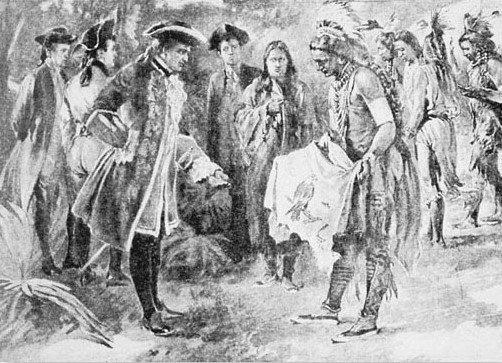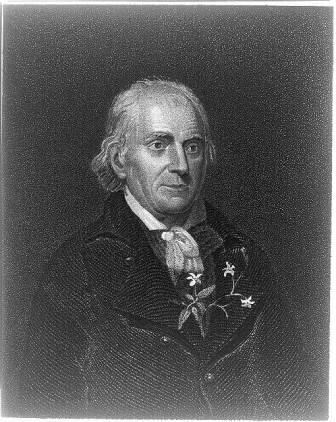|
Ocmulgee Mounds National Historical Park has an astonishing depth to its history. The land here has been occupied for more than 12,000 years by various cultures. The first people to this area where the Paleo Indians, who were nomads passing through the Macon Plateau as they hunted Ice Age megafauna. As the Ice Age receded and warmer climates penetrated the southeastern portion of North America, Archaic Indians began to utilize the Macon Plateau; hunting deer and fish and gathering nuts, berries, and roots. The Woodland Indians were the first to build semi-permanent villages in this area and grow sunflower seeds. 
Ed Jackson Three Creeks That Shaped Georgia's HistoryTomochichi (1644? - 1739) Tomochichi was a chief of the Yamacraw Indians and played an important role in Georgia’s creation. The Yamacraw Indian tribe was an assortment of Creeks created by Tomochichi. The tribe consisted of about 200 people who lived near the Savannah River. When James Oglethorpe arrived in 1733, Oglethorpe wanted to create good relations with the Natives, so he created trade between the Yamacraw. A year after Oglethorpe’s arrival to America, Tomochichi accompanied Oglethorpe back to England to meet English dignitaries. Tomochichi asked for education and fair trade for his people. After returning to the United States, Tomochichi and Oglethorpe joined together in a mission to determine the southern boundaries of Georgia Colony and to create better relations with the Spanish. In 1739, Tomochichi fell ill and passed away in his nineties. He left his wife and nephew in charge of his small tribe. Mary Musgrove (1700 - 1760s) Mary was the daughter of an English trader and a Creek woman of the Wind Clan. She lived in the Creek village of Coweta (Lower Creek town) and in the colony of South Carolina. Mary spoke both Muscogee and English. In 1717 she married an English trader named John Musgrove and established a trading post on the Savannah River. Mary was also James Oglethorpe’s interpreter during the establishment of Georgia Colony. When John Musgrove died in 1735, Mary moved the trading post to the Yamacraw Bluff. The post became a center of trade between the English and Indians. In 1737 Mary married Jacob Matthew and they establish another trading post at Mount Venture on the Altamaha River. Just five years later, Matthew died and Mary married Reverend Thomas Bosomworth. Bosomworth was a Christian missionary, and together they traveled into Creek villages with messages from James Oglethorpe and the English king and brought back speeches from Creek leaders. They occasionally taught Christian missionaries in the Muscogee language, trying to create better relations between the English and the Creeks. Mary died on St. Catherine’s Island, Georgia sometime after 1763. William McIntosh (1778 - 1825) William was born in Coweta (Lower Creek town) to Captain William McIntosh, a Scotsman, and Senoya, a Creek woman of the Wind Clan. He was raised among the Creeks but spent time in Savannah, Georgia, where he learned English. McIntosh supported the idea of “civilizing” the Creeks through supporting the English way of life instead of keeping their traditional way of life. He supported General Andrew Jackson in the Creek War of 1813-1814. McIntosh helped with the United States victory at the Battle of Horsebend in Alabama where the Lower Creeks fought against the “Red Sticks.” The result of the victory forced both the Lower and Upper Creeks to sign a treaty to cede 22 million acres of land in Alabama and South Georgia to the government. By 1825 the government wanted all the Creek land in Georgia. McIntosh participated in the drafting and signing of the Treaty of Indian Springs of 1825. Unfortunately this led to his execution by a contingent of the Upper Creeks led by Chief Menawa. 
William Bartram (1739 - 1823) In 1774, William Bartram, naturalist and botanist, followed the Lower Creek Trading Path from Augusta through this area. In his journal, he recorded this account of the Ocmulgee Old Fields: "On the heights of these low grounds are yet visible monuments, or traces, of an ancient town, such as artificial mounts or terraces, squares and banks, encircling considerable areas. Their old fields and planting land extend up and down the river, fifteen or twenty miles from this site. If we are to give credit to the account the Creeks give of themselves, this place is remarkable for being the first town or settlement, when they sat down (as they term it) or established themselves, after their emigration from the west..." William Bartram observed that the Muscogee households consisted of up to four structures arranged around four sides of a square courtyard. The town square was at the center of the their social, political, and religious life. The town square consisted of four arbors, and in the middle was the sacred fire with four logs, where ceremonies were held. One of the major ceremonies that took place annually was the Green Corn Ceremony. The ceremony celebrated the new harvest and was used as a time to revitilize community ties. |
Last updated: August 1, 2023
